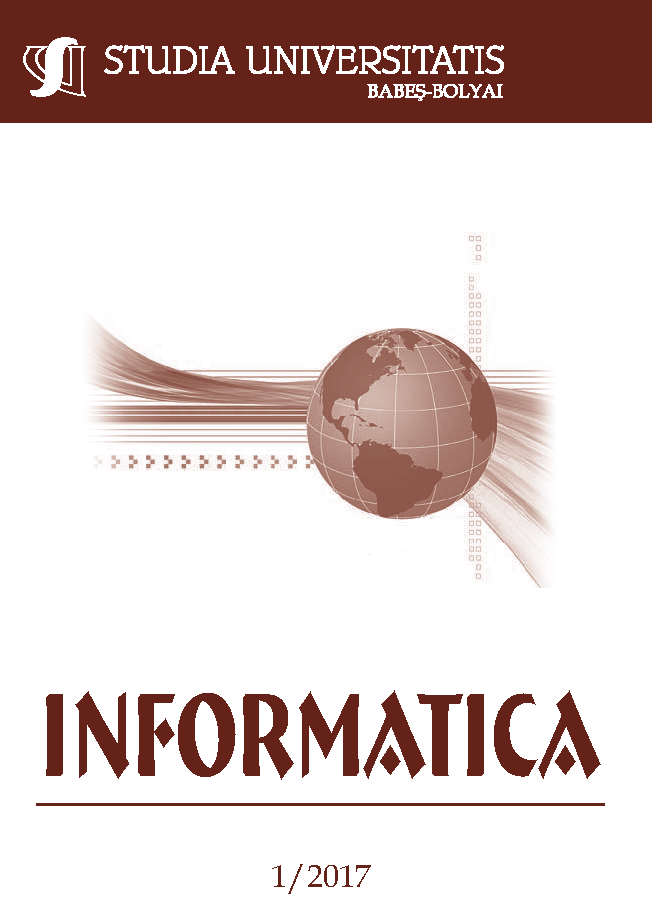MACHINE LEARNING TECHNIQUES FOR DETECTING FALSE SIGNATURES
DOI:
https://doi.org/10.24193/subbi.2017.1.04Keywords:
Machine learning, Convolutional neural networks, Support vector machines, Classification, Signature verification.Abstract
Deciding whether a handwritten signature is legit or it has been falsified is a very complex task. Several methods have been tried out by the graphology experts in order to detect such fraud. However, it is obvious that it is very hard to perform such a classification. In this paper we investigate the possibility to use some supervised learning techniques in order to build models capable to accurately perform such an analysis. The results reported during the testing phase of the obtained model are encouraging for further work.
References
L.D. Brown, T.T. Cai, and A. DasGupta. Interval Estimation for a Binomial Proportion (with discussion). Statistical Science, 16(2):101–133, 2001.
Corinna Cortes and Vladimir Vapnik. Support-vector networks. Machine Learning, 20(3):273–297, 1995.
Tom Fawcett. An introduction to ROC analysis. Pattern Recogn. Lett., 27(8):861–874, 2006.
Mohsen Fayyaz, Mohammad Hajizadeh Saffar, Mohammad Sabokrou, and Mahmood Fathy. Feature representation for online signature verification. CoRR, abs/1505.08153, 2015.
Bence Kovari and Hassan Charaf. Analysis of intraperson variability of features for off-line signature verification. W. Trans. on Comp., 9(11):1359–1368, November 2010.
Bence Kovari and Hassan Charaf. Statistical analysis of signature features with respect to applicability in off-line signature verification. In Proceedings of the 14th WSEAS International Conference on Computers: Part of the 14th WSEAS CSCC Multiconference
- Volume II, ICCOMP’10, pages 473–478, Stevens Point, Wisconsin, USA, 2010. World Scientific and Engineering Academy and Society (WSEAS).
Bence Kovari and Hassan Charaf. A study on the consistency and significance of local features in off-line signature verification. Pattern Recognition Letters, https://www.aut.bme.hu/Pages/Research/Signature/Resources, 2013.
Bence Kovari, Benedek Toth, and Hassan Charaf. Classification approaches in off-line handwritten signature verification. WSEAS TRANSACTIONS on MATHEMATICS Issue 9, 2009.
Y. LeCun, L. Bottou, Y. Bengio, and P. Haffner. Gradient-based learning applied to document recognition. Proceedings of the IEEE, 86(11):2278–2324, November 1998.
Thomas M. Mitchell. Machine learning. McGraw-Hill, Inc. New York, USA, 1997.
Michael A. Nielsen. Neural Networks and Deep Learning. Determination Press, USA, January 2016.
Fabian Pedregosa, Ga¨el Varoquaux, Alexandre Gramfort, Vincent Michel, Bertrand Thirion, Olivier Grisel, Mathieu Blondel, Peter Prettenhofer, Ron Weiss, Vincent Dubourg, Jake Vanderplas, Alexandre Passos, David Cournapeau, Matthieu Brucher, Matthieu Perrot, and Édouard Duchesnay. Scikit-learn: Machine learning in python. J. Mach. Learn. Res., 12:2825–2830, November 2011.
Bernardete Ribeiro, Ivo Gonc¸alves, S´ergio Santos, and Alexander Kovacec. Deep Learning Networks for Off-Line Handwritten Signature Recognition, pages 523–532. Springer Berlin Heidelberg, Berlin, Heidelberg, 2011.
Harish Srinivasan, Sargur N. Srihari, and Matthew J. Beal. Machine Learning for Signature Verification, pages 761–775. Springer Berlin Heidelberg, Berlin, Heidelberg, 2006.
Christian Szegedy, Vincent Vanhoucke, Sergey Ioffe, Jonathon Shlens, and Zbigniew Wojna. Rethinking the inception architecture for computer vision. CoRR, abs/1512.00567, 2015.
Downloads
Published
How to Cite
Issue
Section
License
Copyright (c) 2017 Studia Universitatis Babeș-Bolyai Informatica

This work is licensed under a Creative Commons Attribution-NonCommercial-NoDerivatives 4.0 International License.





